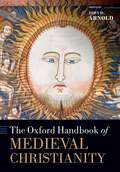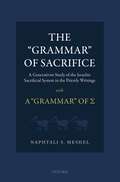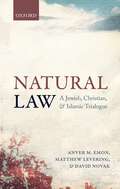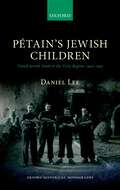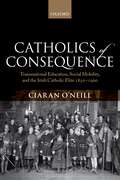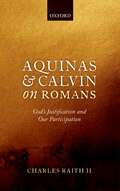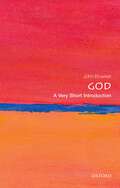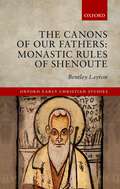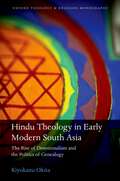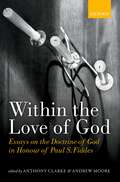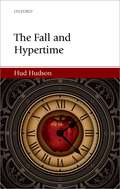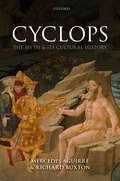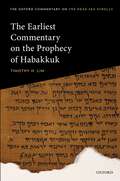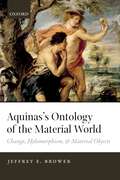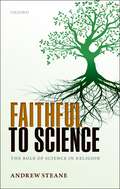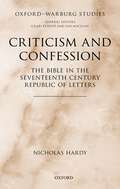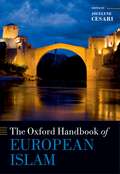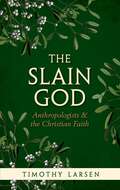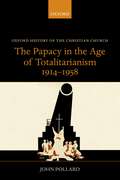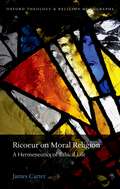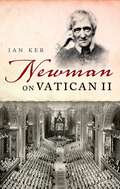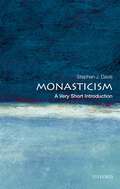- Table View
- List View
The Oxford Handbook of Medieval Christianity (Oxford Handbooks Ser.)
by John H. ArnoldThe Oxford Handbook of Medieval Christianity takes as its subject the beliefs, practices, and institutions of the Christian Church between 400 and 1500AD. It addresses topics ranging from early medieval monasticism to late medieval mysticism, from the material wealth of the Church to the spiritual exercises through which certain believers might attempt to improve their souls. Each chapter tells a story, but seeks also to ask how and why 'Christianity' took particular forms at particular moments in history, paying attention to both the spiritual and otherwordly aspects of religion, and the material and political contexts in which they were often embedded. This Handbook is a landmark academic collection that presents cutting-edge interpretive perspectives on medieval religion for a wide academic audience, drawing together thirty key scholars in the field from the United States, the UK, and Europe. Notably, the Handbook is arranged thematically, and focusses on an analytical, rather than narrative, approach, seeking to demonstrate the variety, change, and complexity of religion throughout this long period, and the numerous different ways in which modern scholarship can approach it. While providing a very wide-ranging view of the subject, it also offers an important agenda for further study in the field.
The 'Grammar' of Sacrifice: A Generativist Study of the Israelite Sacrificial System in the Priestly Writings with A 'Grammar' of Σ
by Naphtali S. MeshelThe notion that rituals, like natural languages, are governed by implicit, rigorous rules led scholars in the last century, harking back to the early Indian grammarian Patañjali, to speak of a "grammar", or "syntax", of ritual, particularly sacrificial ritual. Despite insightful examples of ritual complexes that follow hierarchical rules akin to syntactic structures in natural languages, and ambitious attempts to imagine a Universal Grammar of sacrificial ritual, no single, comprehensive "grammar" of any ritual system has yet been composed. This book offers the first such "grammar." Centering on Σ—the idealized sacrificial system represented in the Priestly laws in the Pentateuch—it demonstrates that a ritual system is describable in terms of a set of concise, unconsciously internalized, generative rules, analogous to the grammar of a natural language. Despite far-reaching diachronic developments, reflected in Second Temple and rabbinic literature, the ancient Israelite sacrificial system retained a highly unchangeable "grammar," which is abstracted and analysed in a formulaic manner. The limits of the analogy to linguistics are stressed: rather than categories borrowed from linguistics, such as syntax and morphology, the operative categories of Σ are abstracted inductively from the ritual texts: zoemics—the study of the classes of animals used in ritual sacrifice; jugation-the rules governing the joining of animal and non-animal materials; hierarchics-the tiered structuring of sacrificial sequences; and praxemics—the analysis of the physical activity comprising sacrificial procedures. Finally, the problem of meaning in non-linguistic ritual systems is addressed.
Natural Law: A Jewish, Christian, and Islamic Trialogue
by Anver M. Emon Matthew Levering David NovakThis book is an examination of natural law doctrine, rooted in the classical writings of our respective three traditions: Jewish, Christian, and Islamic. Each of the authors provides an extensive essay reflecting on natural law doctrine in his tradition. Each of the authors also provides a thoughtful response to the essays of the other two authors. Readers will gain a sense for how natural law (or cognate terms) resonated with classical thinkers such as Maimonides, Origen, Augustine, al-Ghazali and numerous others. Readers will also be instructed in how the authors think that these sources can be mined for constructive reflection on natural law today. A key theme in each essay is how the particularity of the respective religious tradition is squared with the evident universality of natural law claims. The authors also explore how natural law doctrine functions in particular traditions for reflection upon the religious other.
Pétain's Jewish Children: French Jewish Youth And The Vichy Regime, 1940-1942 (Oxford Historical Monographs)
by Daniel LeePétain's Jewish Children examines the nature of the relationship between the Vichy regime and its Jewish citizens in the period 1940 to 1942. Previous studies have generally viewed the experiences of French Jewry during the Second World War through the lenses of persecution, resistance, or rescue; an approach which has had the unintended effect of stripping Jewish actors of their agency. This volume, however, draws attention to the specific category of French Jewish youth which reveals significant exceptions to Vichy's antisemitic policies, wherein the regime's desire for a reinvigorated youth and the rebirth of the nation took precedence over its racial laws. While Jews were becoming marginalised from the civil service and liberal professions, the New Order did not seek to exclude young French Jews from participating in a series of youth projects that aimed to rebuild France in the aftermath of its defeat to Germany. For example, the Jewish scouts' emphasis on manual work and a return to the land ensured that it was looked upon favourably by Vichy, who rewarded the scouts financially. Similarly, young French Jews were called up to take part in the Chantiers de la Jeunesse, Vichy's alternative to compulsory military service. In considering the roles of some of Vichy's lesser known ministers with responsibilities for youth, for whom antisemitism was not a priority, Pétain's Jewish Children illuminates the tensions between Vichy's ambition for national regeneration and its racial policies, rendering any simple account of its antisemitism misleading. While hindsight may point to the contrary, this volume shows that the emergence of the new regime did not signal the beginning of the end for French Jewry. In Vichy's first two years, while ambiguity reigned, possibilities to integrate and participate with the New Order endured and Jews were constantly presented with new avenues to probe and explore. After this point, the drastic policy changes fuelled by Prime Minister Pierre Laval and the head of Vichy Police, René Bousquet, coupled with the total occupation of France by German forces in November 1942, reduced the possibilities for coexistence almost to nothing.
Catholics Of Consequence: Transnational Education, Social Mobility, And The Irish Catholic Elite 1850-1900
by Ciaran O'NeillFor as far back as school registers can take us, the most prestigious education available to any Irish child was to be found outside Ireland. Catholics of Consequence traces, for the first time, the transnational education, careers, and lives of more than two thousand Irish boys and girls who attended Catholic schools in England, France, Belgium, and elsewhere in the second half of the nineteenth century. There was a long tradition of Irish Anglicans, Protestants, and Catholics sending their children abroad for the majority of their formative years. However, as the cultural nationalism of the Irish revival took root at the end of the nineteenth century, Irish Catholics who sent their children to school in Britain were accused of a pro-Britishness that crystallized into still recognisable terms of insult such as West Briton, Castle Catholic, Squireen, and Seoinin. This concept has an enduring resonance in Ireland, but very few publications have ever interrogated it. Catholics of Consequence endeavours to analyse the education and subsequent lives of the Irish children that received this type of transnational education. It also tells the story of elite education in Ireland, where schools such as Clongowes Wood College and Castleknock College were rooted in the continental Catholic tradition, but also looked to public schools in England as exemplars. Taken together the book tells the story of an Irish Catholic elite at once integrated and segregated within what was then the most powerful state in the world.
Aquinas And Calvin On Romans: God's Justification And Our Participation
by Charles Raith IIAquinas and Calvin on Romans is a comparative study of John Calvin's and Thomas Aquinas's commentaries on the first eight chapters of Paul's letter to the Romans. Focusing on the role of human participation in God's work of salvation, Charles Raith argues that Calvin's critiques of the "schoolmen" arising from his reading of Romans fail to find a target in Aquinas's theology while Calvin's principal positive affirmations are embraced by Aquinas as well. Aquinas upholds many fundamental insights that Calvin would later also obtain in his reading of Romans, such as justification sola fide non merito (by faith alone and not by merit), the centrality of Christ for salvation, the ongoing imperfection of the sanctified life, the work of the Spirit guiding the believer along the path of sanctification, and the assurance of salvation that one obtains through the indwelling of the Spirit, to name only a few. Even more, numerous identical interpretations arising in their commentaries makes it necessary to consider Calvin's reading of Romans as appropriating a tradition of interpretation that includes Aquinas. At the same time, the nonparticipatory dimensions of Calvin's reading of Romans becomes clear when set beside Aquinas's reading, and these nonparticipatory dimensions create difficulties for Calvin's interpretation, especially on Romans 8, that are not present in Aquinas's account. Raith therefore suggests how Calvin's reading of Romans, especially as it pertains to justification and merit, should be augmented by the participatory framework reflected in Aquinas's interpretation. The book concludes by revisiting Calvin's criticisms of the Council of Trent in light of these suggestions.
God: A Very Short Introduction (Very Short Introductions)
by John BowkerWho or what is God? How do different religions interpret God's existence? How can we know God? Many people believe in God; not just throughout history but also in the present day. But who or what is it they believe in? Many different and sometimes conflicting answers have been suggested to this question. This Very Short Introduction explores some of the answers provided by philosophers, poets, and theologians, and considers why some people believe in God and others do not. John Bowker explores how the major religions established their own distinctive beliefs about God and how they interpret God's existence, and concludes by looking at how our understanding of God continues to evolve. ABOUT THE SERIES: The Very Short Introductions series from Oxford University Press contains hundreds of titles in almost every subject area. These pocket-sized books are the perfect way to get ahead in a new subject quickly. Our expert authors combine facts, analysis, perspective, new ideas, and enthusiasm to make interesting and challenging topics highly readable.
God: A Brief History (Very Short Introductions Ser.)
by John BowkerWho or what is God? How do different religions interpret God's existence? How can we know God? Many people believe in God; not just throughout history but also in the present day. But who or what is it they believe in? Many different and sometimes conflicting answers have been suggested to this question. This Very Short Introduction explores some of the answers provided by philosophers, poets, and theologians, and considers why some people believe in God and others do not. John Bowker explores how the major religions established their own distinctive beliefs about God and how they interpret God's existence, and concludes by looking at how our understanding of God continues to evolve. ABOUT THE SERIES: The Very Short Introductions series from Oxford University Press contains hundreds of titles in almost every subject area. These pocket-sized books are the perfect way to get ahead in a new subject quickly. Our expert authors combine facts, analysis, perspective, new ideas, and enthusiasm to make interesting and challenging topics highly readable.
The Canons of Our Fathers: Monastic Rules of Shenoute (Oxford Early Christian Studies)
by Bentley LaytonThis book is the first publication of a very early set of Christian monastic rules from Roman Egypt, accompanied by four preliminary chapters discussing their historical and social context and their character as rules. These rules were found quoted in the writings of the great Egyptian monastic leader Shenoute. Designed for a federation of monks and nuns who banded together about 360 CE—forming the so-called "White Monastery Federation"—the rules date back to the fourth and fifth centuries. New historical evidence is presented for the founding of the Federation. Providing almost the earliest evidence for Christian communal (cenobitic) monasticism, the rules depict many intimate aspects of ascetic practice. Details of monastic daily life are mentioned in passing in the rules, and the author uses these details to describe their picture of monastic life under five general topics: the monastery as a physical plant, the human makeup of the community, ascetic observances, the hierarchy of authority, and the daily liturgy. The book includes a clear English translation of the rules accompanied by the original Coptic text, amounting to five hundred and ninety-five entries.
Hindu Theology In Early Modern South Asia: The Rise Of Devotionalism And The Politics Of Genealogy (Oxford Theology and Religion Monographs)
by Kiyokazu OkitaFocusing on the idea of genealogical affiliation (sampradāya), Kiyokazu Okita explores the interactions between the royal power and the priestly authority in eighteenth-century north India. He examines how the religious policies of Jaisingh II (1688-1743) of Jaipur influenced the self-representation of Gauḍīya Vaiṣṇavism, as articulated by Baladeva Vidyābhūṣaṇa (ca. 1700-1793). Gauḍīya Vaiṣṇavism centred around God Kṛṣṇa was inaugurated by Caitanya (1486-1533) and quickly became one of the most influential Hindu devotional movements in early modern South Asia. In the increasingly volatile late Mughal period, Jaisingh II tried to establish the legitimacy of his kingship by resorting to a moral discourse. As part of this discourse, he demanded that religious traditions in his kingdom conform to what he conceived of as Brahmaṇicaly normative. In this context the Gauḍīya school was forced to deal with their lack of clear genealogical affiliation, lack of an independent commentary on the Brahmasūtras, and their worship of Goddess Radha and Kṛṣṇa, who, according to the Gauḍīyas, were not married. Based on a study of Baladeva's Brahmasūtra commentary, Kiyokazu Okita analyses how the Gauḍīyas responded to the king's demand.
Within the Love of God: Essays on the Doctrine of God in Honour of Paul S. Fiddes
The doctrine of God is central to theology for it determines the way in which other regions of Christian doctrine are articulated, yet work on this topic in its own right has been occluded recently by treatments of the Trinity or divine passibility. This collection of specially commissioned essays presents major treatments of key themes in the doctrine of God, motivated by but not restricted to the work of Professor Paul S. Fiddes to whom it is offered as a Festschrift. It includes invigorating discussions of the biblical and non-biblical sources for the doctrine of God, and the section on 'Metaphysics and the Doctrine of God' examines some of the most important conceptual questions arising in contemporary theological debate about the being and nature of God, and God's relations to the world. The final section of the book on 'God and Humanity' will be highly relevant to scholars working in the fields of theological anthropology, moral and political theology, on inter-faith relations, on theology and literature, or who are interested in the impact of contemporary science on the doctrine of God. The introduction relates the essays in the book to the work of Professor Fiddes and to wider debates in Christian doctrine. This volume brings together a team of internationally distinguished scholars from a wide range of theological, philosophical, and religious perspectives, and it will stimulate fresh thinking and new debate about this most central of topics in Christian theology.
The Fall and Hypertime
by Hud HudsonFrequently, alleged irreconcilable conflicts between science and religion are instead misdescribed battles concerning negotiable philosophical assumptions—conflicts between metaphysics and metaphysics. Hud Hudson provides a two-stage illustration of this claim with respect to the putative inconsistency between the doctrines of The Fall and Original Sin and the deliverances of contemporary science. The tension in question emerges through a study of the many forms the religious doctrines have assumed over the centuries and through a review of some well-established scientific lessons on the origin and history of the universe and of human persons. The first stage: After surveying various paths of retreat which involve reinterpreting and impoverishing Original Sin and minimizing and dehistoricizing The Fall, one version of moderate realism about the doctrines is articulated, critically evaluated, and found both consistent with contemporary science and suitable to play a crucial role in the theist's confrontation with the Problem of Evil. The second stage: Recent work in the philosophy of time and in the philosophy of religion provides intriguing support for a Hypertime Hypothesis (a species of multiverse hypothesis), distinctive for positing a series of successive hypertimes, each of which hosts a spacetime block. After arguing that the Hypertime Hypothesis is a genuine epistemic possibility and critically discussing its impact on a number of debates in metaphysics and philosophy of religion, Hudson reveals a strategy for unabashed, extreme literalism concerning The Fall and Original Sin which nevertheless has the extraordinary and delightful feature of being thoroughly consistent with the reigning scientific orthodoxy.
Cyclops: The Myth and its Cultural History
by Mercedes Aguirre Richard BuxtonA Cyclops is popularly assumed to be nothing more than a flesh-eating, one-eyed monster. In an accessible, stylish, and academically authoritative investigation, this book seeks to demonstrate that there is far more to it than that - quite apart from the fact that in myths the Cyclopes are not always one-eyed! This book provides a detailed, innovative, and richly illustrated study of the myths relating to the Cyclopes from classical antiquity until the present day. The first part is organised thematically: after discussing various competing scholarly approaches to the myths, the authors analyse ancient accounts and images of the Cyclopes in relation to landscape, physique (especially eyes, monstrosity, and hairiness), lifestyle, gods, names, love, and song. While the man-eating Cyclops Polyphemus, famous already in the Odyssey, plays a major part, so also do the Cyclopes who did monumental building work, as well as those who toiled as blacksmiths. The second part of the book concentrates on the post-classical reception of the myths, including medieval allegory, Renaissance grottoes, poetry, drama, the visual arts, contemporary painting and sculpture, film, and even a circus performance. This book aims to explore not just the perennial appeal of the Cyclopes as fearsome monsters, but the depth and subtlety of their mythology which raises complex issues of thought and emotion.
The Earliest Commentary on the Prophecy of Habakkuk (Oxford Commentary on the Dead Sea Scrolls)
by Timothy H. LimThis is the first major commentary in English on Pesher Habakkuk for forty years. It elucidates the nature of 1QpHab as the earliest commentary on the prophecy of Habakkuk by a detailed study of the biblical quotation and sectarian interpretation. This commentary provides a new edition of the scroll, including new readings, and detailed palaeographical, philological, exegetical and historical notes and discussion. It shows that the pesherist imitates the allusive style of the oracles of Habakkuk and also draws on lexemes, phrases, and themes from other biblical texts and Jewish sources. It shows that the pesherist identified the Kittim with the Romans who conquered Judaea in 63 BCE, and suggests that the scroll refers to several righteous and wicked figures, including the last Hasmonean high priests.
Aquinas's Ontology Of The Material World: Change, Hylomorphism, And Material Objects
by Jeffrey E. BrowerWhat is the nature of the material world? And how are its fundamental constituents to be described? These questions are of central concern to contemporary philosophers, and in their attempt to answer them, they have begun reconsidering traditional views about metaphysical structure, including the Aristotelian view that material objects are best described as 'hylomorphic compounds'—that is, objects composed of both matter (hyle) and form (morphe). In this major new study, Jeffrey E. Brower presents and explains the hylomorphic conception of the material world developed by Thomas Aquinas, the most influential Aristotelian of the Middle Ages. According to Brower, the key to understanding Aquinas's conception lies in his distinctive account of intrinsic change. Beginning with a novel analysis of this account, Brower systematically introduces all the elements of Aquinas's hylomorphism, showing how they apply to material objects in general and human beings in particular. The resulting picture not only sheds new light on Aquinas's ontology as a whole, but provides a wholesale alternative to the standard contemporary accounts of material objects. In addition to presenting and explaining Aquinas's views, Brower seeks wherever possible to bring them into dialogue with the best recent literature on related topics. Along the way, he highlights the contribution that Aquinas's views make to a host of contemporary metaphysical debates, including the nature of change, composition, material constitution, the ontology of stuff vs. things, the proper analysis of ordinary objects, the truthmakers for essential vs. accidental predication, and the metaphysics of property possession.
Faithful to Science: The Role of Science in Religion
by Andrew SteaneScience and religious faith are two of the most important and influential forces in human life, yet there is widespread confusion about how, or indeed whether, they link together. This book describes this combination from the perspective of one who finds that they link together productively and creatively. The situation is not one of conflict or uneasy tension, or even a respectful dialogue. Rather, a lively and well-founded faith in God embraces and includes science, and scientific ways of thinking, in their proper role. Science is an activity right in the bloodstream of a reasonable faith. The book interprets theism broadly, and engages carefully with atheism, while coming from a Christian perspective. The aim is to show what science is, and what it is not, and at the same time give some pointers to what theism is or can be. Philosophy, evolution and the nature of science and human life are discussed in the first part of the book, questions of origins in the second. It is the very mind-set of scientific thinking that is widely supposed to be antagonistic to religious faith. But such suspicions are too sweeping. They misunderstand both faith and science. Faith can be creative and intellectually courageous; science is not the all-embracing story that it is sometimes made out to be. It is not that science fails to explain some things, but rather, it does not explain anything at all, on its own. It is part of a larger explanation. And even explanation has to take a humble place; it is not the purpose of life.
Criticism and Confession: The Bible in the Seventeenth Century Republic of Letters (Oxford-Warburg Studies)
by Nicholas HardyThe period between the late Renaissance and the early Enlightenment has long been regarded as the zenith of the 'republic of letters', a pan-European community of like-minded scholars and intellectuals who fostered critical approaches to the study of the Bible and other ancient texts, while renouncing the brutal religio-political disputes that were tearing their continent apart at the same time. Criticism and Confession offers an unprecedentedly comprehensive challenge to this account. Throughout this period, all forms of biblical scholarship were intended to contribute to theological debates, rather than defusing or transcending them, and meaningful collaboration between scholars of different confessions was an exception, rather than the norm. 'Neutrality' was a fiction that obscured the ways in which scholarship served the interests of ecclesiastical and political institutions. Scholarly practices varied from one confessional context to another, and the progress of 'criticism' was never straightforward. The study demonstrates this by placing scholarly works in dialogue with works of dogmatic theology, and comparing examples from multiple confessional and national contexts. It offers major revisionist treatments of canonical figures in the history of scholarship, such as Joseph Scaliger, Isaac Casaubon, John Selden, Hugo Grotius, and Louis Cappel, based on unstudied archival as well as printed sources; and it places those figures alongside their more marginal, overlooked counterparts. It also contextualizes scholarly correspondence and other forms of intellectual exchange by considering them alongside the records of political and ecclesiastical bodies. Throughout, the study combines the methods of the history of scholarship with techniques drawn from other fields, including literary, political, and religious history. As well as presenting a new history of seventeenth-century biblical criticism, it also critiques modern scholarly assumptions about the relationships between erudition, humanistic culture, political activism, and religious identity.
The Oxford Handbook of European Islam (Oxford Handbooks)
For centuries, Muslim countries and Europe have engaged one another through theological dialogues, diplomatic missions, political rivalries, and power struggles. In the last thirty years, due in large part to globalization and migration from Islamic countries to the West, what was previously an engagement across national and cultural boundaries has increasingly become an internalized encounter within Europe itself. Questions of the Hijab in schools, freedom of expression in the wake of the Danish Cartoon crisis, and the role of Shari'a have come to the forefront of contemporary European discourse. The Oxford Handbook of European Islam is the first collection to present a comprehensive approach to the multiple and changing ways Islam has been studied across European countries. Parts one to three address the state of knowledge of Islam and Muslims within a selection of European countries, while presenting a critical view of the most up-to-date data specific to each country. These chapters analyse the immigration cycles and policies related to the presence of Muslims, tackling issues such as discrimination, post-colonial identity, adaptation, and assimilation. The thematic chapters, in parts four and five, examine secularism, radicalization, Shari'a, Hijab, and Islamophobia with the goal of synthesizing different national discussion into a more comparative theoretical framework. The Handbook attempts to balance cutting edge assessment with the knowledge that the content itself will eventually be superseded by events. Featuring eighteen newly-commissioned essays by noted scholars in the field, this volume will provide an excellent resource for students and scholars interested in European Studies, immigration, Islamic studies, and the sociology of religion.
The Slain God: Anthropologists and the Christian Faith
by Timothy LarsenThroughout its entire history, the discipline of anthropology has been perceived as undermining, or even discrediting, Christian faith. Many of its most prominent theorists have been agnostics who assumed that ethnographic findings and theories had exposed religious beliefs to be untenable. E. B. Tylor, the founder of the discipline in Britain, lost his faith through studying anthropology. James Frazer saw the material that he presented in his highly influential work, The Golden Bough, as demonstrating that Christian thought was based on the erroneous thought patterns of 'savages.' On the other hand, some of the most eminent anthropologists have been Christians, including E. E. Evans-Pritchard, Mary Douglas, Victor Turner, and Edith Turner. Moreover, they openly presented articulate reasons for how their religious convictions cohered with their professional work. Despite being a major site of friction between faith and modern thought, the relationship between anthropology and Christianity has never before been the subject of a book-length study. In this groundbreaking work, Timothy Larsen examines the point where doubt and faith collide with anthropological theory and evidence.
The Papacy in the Age of Totalitarianism, 1914-1958 (Oxford History of the Christian Church)
by John PollardThe Papacy in the Age of Totalitarianism, 1914-1958 examines the most momentous years in papal history. Popes Benedict XV (1914-1922), Pius XI (1922-1939), and Pius XII (1939-1958) faced the challenges of two world wars and the Cold War, and threats posed by totalitarian dictatorships like Italian Fascism, German National Socialism, and Communism in Russia and China. The wars imposed enormous strains upon the unity of Catholics and the hostility of the totalitarian regimes to Catholicism lead to the Church facing persecution and martyrdom on a scale similar to that experienced under the Roman Empire and following the French Revolution. At the same time, these were years of growth, development, and success for the papacy. Benedict healed the wounds left by the 'modernist' witch hunt of his predecessor and re-established the papacy as an influence in international affairs through his peace diplomacy during the First World War. Pius XI resolved the 'Roman Question' with Italy and put papal finances on a sounder footing. He also helped reconcile the Catholic Church and science by establishing the Pontifical Academy of Sciences and took the first steps to move the Church away from entrenched anti-Semitism. Pius XI continued his predecessor's policy of the 'indigenisation' of the missionary churches in preparation for de-colonisation. Pius XII fully embraced the media and other means of publicity, and with his infallible promulgation of the Assumption in 1950, he took papal absolutism and centralism to such heights that he has been called the 'last real pope'. Ironically, he also prepared the way for the Second Vatican Council.
The Papacy in the Age of Totalitarianism, 1914–1958 (Oxford History Of The Christian Church Ser.)
by John PollardThe Papacy in the Age of Totalitarianism, 1914-1958 examines the most momentous years in papal history. Popes Benedict XV (1914-1922), Pius XI (1922-1939), and Pius XII (1939-1958) faced the challenges of two world wars and the Cold War, and threats posed by totalitarian dictatorships like Italian Fascism, German National Socialism, and Communism in Russia and China. The wars imposed enormous strains upon the unity of Catholics and the hostility of the totalitarian regimes to Catholicism lead to the Church facing persecution and martyrdom on a scale similar to that experienced under the Roman Empire and following the French Revolution. At the same time, these were years of growth, development, and success for the papacy. Benedict healed the wounds left by the 'modernist' witch hunt of his predecessor and re-established the papacy as an influence in international affairs through his peace diplomacy during the First World War. Pius XI resolved the 'Roman Question' with Italy and put papal finances on a sounder footing. He also helped reconcile the Catholic Church and science by establishing the Pontifical Academy of Sciences and took the first steps to move the Church away from entrenched anti-Semitism. Pius XI continued his predecessor's policy of the 'indigenisation' of the missionary churches in preparation for de-colonisation. Pius XII fully embraced the media and other means of publicity, and with his infallible promulgation of the Assumption in 1950, he took papal absolutism and centralism to such heights that he has been called the 'last real pope'. Ironically, he also prepared the way for the Second Vatican Council.
Ricoeur On Moral Religion: A Hermeneutics Of Ethical Life (Oxford Theology and Religion Monographs)
by James CarterIn Ricoeur on Moral Religion, James Carter argues that Paul Ricoeur's later philosophical writings provide a highly instructive interpretive key with which to assess his philosophical project as a whole. This first systematic study of the 'later Ricoeur' offers a critical yet sympathetic reconstruction of Ricoeur's hermeneutics of ethical life, which demonstrates his significant contribution to contemporary philosophy of religion and moral philosophy. What emerges is a clear and distinctive moral religion that binds humans together universally on the basis of the life they share as capable beings. Carter also uncovers a hitherto unforeseen thread in Ricoeur's writings concerning ethical life, pulled through his own readings of Spinoza, Aristotle, and Kant. Ricoeur's hermeneutics is structured by a Kantian architectonic informed at different levels by these three philosophers, who ground a rich, holistic, and ultimately rationalist account of ethical life and religion that resists the trappings of both positivism and postmodernism.
Newman on Vatican II
by Ian KerJohn Henry Newman is often described as 'the Father of the Second Vatican Council'. He anticipated most of the Council's major documents, as well as being an inspiration to the theologians who were behind them. His writings offer an illuminating commentary both on the teachings of the Council and the way these have been implemented and interpreted in the post-conciliar period. This book is the first sustained attempt to consider what Newman's reaction to Vatican II would have been. As a theologian who on his own admission fought throughout his life against theological liberalism, yet who pioneered many of the themes of the Council in his own day, Newman is best described as a conservative radical who cannot be classed simply as either a conservative or liberal Catholic. At the time of the First Vatican Council, Newman adumbrated in his private letters a mini-theology of Councils, which casts much light on Vatican II and its aftermath. The leading Newman scholar, Ian Ker, argues that Newman would have greatly welcomed the reforms of the Council, but would have seen them in the light of his theory of doctrinal development, insisting that they must certainly be understood as changes but changes in continuity rather than discontinuity with the Church's tradition and past teachings. He would therefore have endorsed the so-called 'hermeneutic of reform in continuity' in regard to Vatican II, a hermeneutic first formulated by Pope Benedict XVI and subsequently confirmed by his successor, Pope Francis, and rejected both 'progressive' and ultra-conservative interpretations of the Council as a revolutionary event. Newman believed that what Councils fail to speak of is of great importance, and so a final chapter considers the kind of evangelization—a topic notably absent from the documents of Vatican II—Newman thought appropriate in the face of secularization.
Monasticism: A Very Short Introduction (Very Short Introductions)
by Stephen J. DavisMonasticism is a social and religious phenomenon which originated in antiquity and which still remains relevant in the twenty-first century. But what, exactly, is it, and how is it distinguished from other kinds of religious and non-religious practice? In this Very Short Introduction Stephen J. Davis discusses the history of monasticism, from our earliest evidence for it, and the different types which have developed from antiquity to the present day. He considers where monasteries are located, from East Asia to North America, and everywhere in between, and how their settings impact the everyday life and worldview of the monks and nuns who dwell there. Exploring how monastic communities are organized, he also looks at how aspects of life like food, sleep, sex, work, and prayer are regimented. Finally, Davis discusses what the stories about saints communicate about monastic identity and ethics, and considers what place there is for monasticism in the modern world. ABOUT THE SERIES: The Very Short Introductions series from Oxford University Press contains hundreds of titles in almost every subject area. These pocket-sized books are the perfect way to get ahead in a new subject quickly. Our expert authors combine facts, analysis, perspective, new ideas, and enthusiasm to make interesting and challenging topics highly readable.
Monasticism: A Very Short Introduction (Very Short Introductions)
by Stephen J. DavisMonasticism is a social and religious phenomenon which originated in antiquity and which still remains relevant in the twenty-first century. But what, exactly, is it, and how is it distinguished from other kinds of religious and non-religious practice? In this Very Short Introduction Stephen J. Davis discusses the history of monasticism, from our earliest evidence for it, and the different types which have developed from antiquity to the present day. He considers where monasteries are located, from East Asia to North America, and everywhere in between, and how their settings impact the everyday life and worldview of the monks and nuns who dwell there. Exploring how monastic communities are organized, he also looks at how aspects of life like food, sleep, sex, work, and prayer are regimented. Finally, Davis discusses what the stories about saints communicate about monastic identity and ethics, and considers what place there is for monasticism in the modern world. ABOUT THE SERIES: The Very Short Introductions series from Oxford University Press contains hundreds of titles in almost every subject area. These pocket-sized books are the perfect way to get ahead in a new subject quickly. Our expert authors combine facts, analysis, perspective, new ideas, and enthusiasm to make interesting and challenging topics highly readable.
